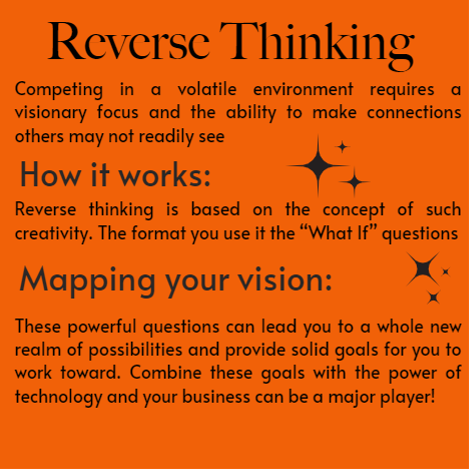
“Vision without action is dreaming. Action without Vision is random activity. Vision is random activity. Vision and action together can change the world!” There are the words of Joe Barker. Write them down and post them in your office. Think about their meaning. As a manager you are responsible for creating the future of your organisation; without it, your daily tasks run the risk of becoming random activities as you manage outcoming crises instead of leading towards a goal. Moreover, competing in a volatile environment requires a visionary focus and the ability to make connections others may not readily see.
So, if you’re a one-person, three-person or fifteen-person-based operation starving to complete globally in a corporate-dominated industry, how do you maintain, a vision and ensure that your marketing, administration, customer service and product development is innovative as it can be? Start with reverse thinking and consider all the “what if” possibilities.
How does Reverse Thinking Work
Click here to view a video that explains how reverse thinking works.
Creativity is the realignment of two or more ideas (or objects or elements) into relationships with each other that did not previously exist. If you’ve ever bent a paper clip and used it as a makeshift letter opener, you’ve committed a creative act. Finding yourself without a letter opener, you decided to realign the configuration of the paper clip in order to expand its utility. Reverse thinking is based on the concept of such creativity. The format you use is the “What If” questions.
Asking “What If” questions require you to break the cardinal rule. “Never assume anything.” Suspend reality for a specified time period and assume freely. Making assumptions allows you to realign relationships and consider new options. The wilder the questions and assumptions, the better. Why? Because when you allow yourself to concoct wild possibilities, you give your imagination the freedom it needs to develop kernels of substance that you may be able to adapt into viable and effective solutions.
Here’s an example: Several years ago, a trade association was grappling with the problem of gaining the attention of legislators. Using reverse thinking, the group considered ideas by asking itself ‘what if” questions: What if they sneaked into the legislature, hidden inside a Trojan horse? What if they kidnapped members of the legislature and spirited them away to an isolated locale, so they could have their undivided attention? These crazy ideas obviously couldn’t be implemented, but these were kernels of possibility within them: to do something that would be attention-getting, in short, to create a media “splash”. The group worked further on this idea and came up with such a creative and effective media program, that they found themselves “splashed” on the front page of the Wall Street Journal soon afterwards. Had they not considered the crazy “What If” possibilities, such a media campaign might never have occurred?
Skilful Use of “What If” Questions
For challenges related to marketing, you might ask:
- What if we used mental telepathy to reach our most valued customers?
- How would that work and what would the results be?
- What if we expanded into a market that had no use for our product?
- What new uses might we find for it?
For challenges related to product development, you might ask:
- What if we could convince our customers not to buy this product?
- What would we say?
- What if we could have this product do one thing and one thing only?
- What could it be?
For challenges related to staffing, you might ask:
- What if we required all applicants to state why they wouldn’t want to work here?
- What answers would we be looking for?
- What if we provided everyone working on a tight deadline project with running shoes?
- What could the effect be?
Using Reverse Thinking to Map Your Vision
You might be surprised by some of the innovative solutions that come from “What If” questioning. And when you are mapping out a vision for your organisation or yourself this technique can be extremely powerful. You might start by drawing a picture of how you see your business in the future – three, five or ten years from now. Be as detailed as possible. Include all facets of your life, organisation, people, products, and customers. Your picture can be symbolic or realistic, colourful or monotone. When it’s complete, hold it up and look at it intently. What elements within the picture surprise you? What new relationships are suggested? New products or services? Take these new thoughts and create “What If” questions out of them. What if your organisation was to become the largest market-share holder in Central Africa three years from now? What if your current cash cow was to be overtaken by your other products and services? What if your current customer base were to shrink by 20 % over the next five years?
These powerful questions can lead you to a whole new realm of possibilities and provide solid goals for you to work toward. Combine these goals with the power of technology and your business can be a major player!